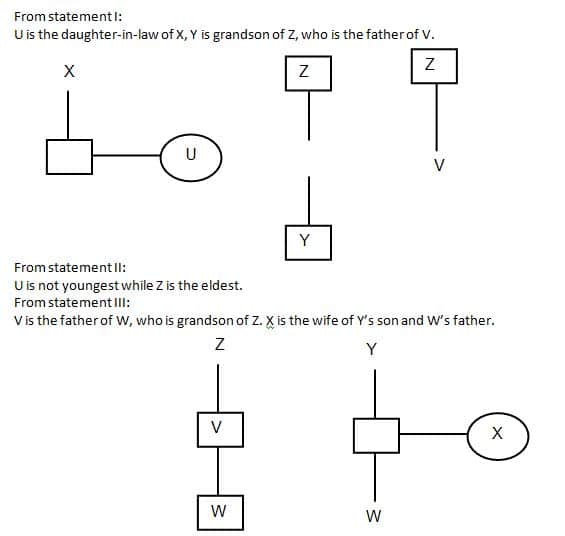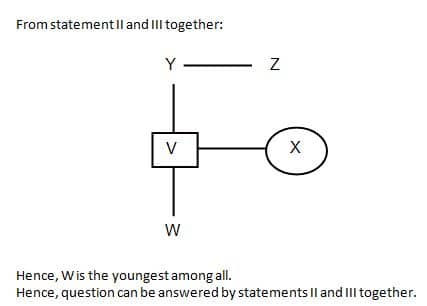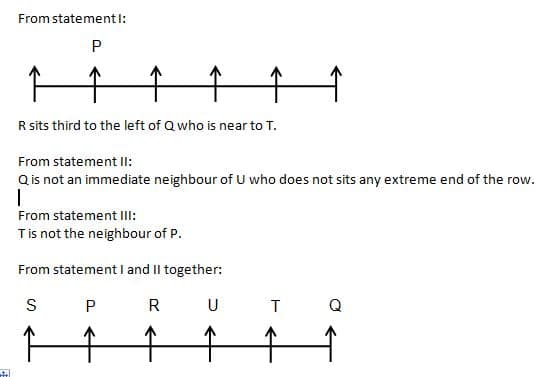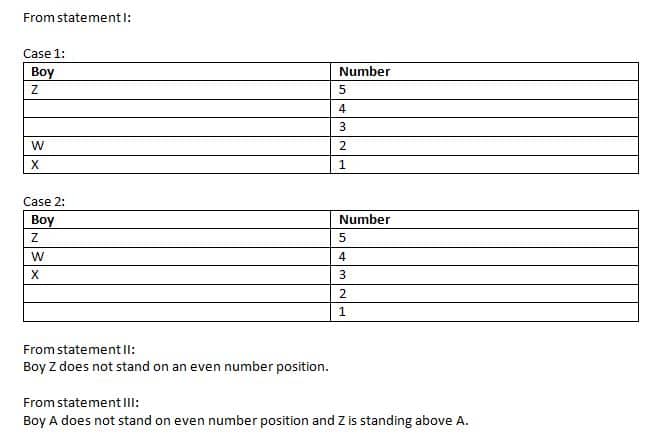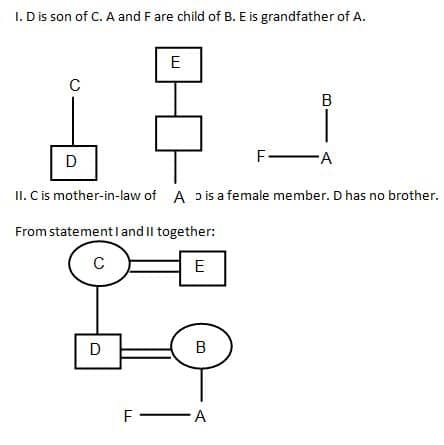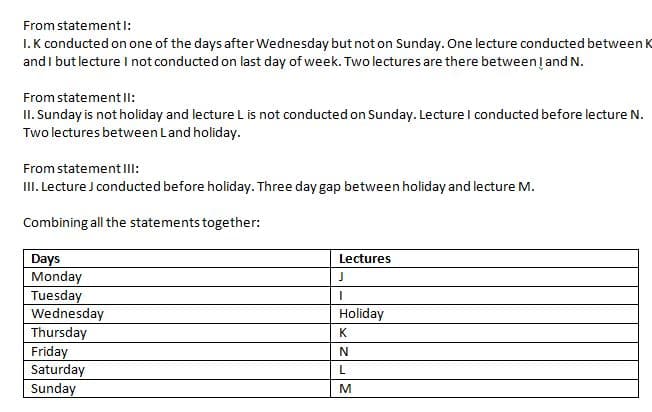Hello Aspirants,
Welcome to Online Quantitative Aptitude section in AffairsCloud.com. Here we are creating question sample From DATA SUFFICIENCY which is BASED ON Bank EXAMS 2019 !!!
Directions: Study the following information and answer the questions given below:
- Who is youngest among six family members U, V, W, X, Y and Z?
I. U is the daughter-in-law of X, Y is grandson of Z, who is the father of V.
II. U is not youngest while Z is the eldest.
III. V is the father of W, who is grandson of Z. X is the wife of Y’s son and W’s father.
1) If the data in statement I and II are sufficient to answer the question, while the data in statement III are not sufficient to answer the question.
2) If the data in statement I alone or in the statement II alone or in the statement III alone is sufficient to answer the question.
3) If the data in statement I and III are sufficient to answer the question, while the data in statement II is not sufficient to answer the question.
4) If the data in statement II and III are sufficient to answer the question, while the data in statement I is not sufficient to answer the question.
5) If the data in all the statement I, II and III are necessary to answer the questionAnswer – 4
Explanation :


- A’ is in which direction with respect to ‘B’?
(I) C is north of B and west of D who is south of E.
(II) D is west of F who is north east of A who is north of H.
(III) A is north of G and south west of C.
1) If the data in statement I and II are sufficient to answer the question, while the data in statement III are not sufficient to answer the question.
2) If the data in statement I and III are sufficient to answer the question, while the data in statement II is not sufficient to answer the question.
3) If the data in statement II and III are sufficient to answer the question, while the data in statement I is not sufficient to answer the question.
4) If the data in statement I alone or in the statement II alone or in the statement III alone is sufficient to answer the question.
5) If the data in all the statement I, II and III together are not sufficient to answer the question.Answer – 5
Explanation :

- Six persons P, Q, R, S, T and U are sitting in a row facing in the north direction. Who sits between R and T?
(I) P sits second from the left end. R sits third to the left of Q who is near to T.
(II) Q is not an immediate neighbour of U who does not sits any extreme end of the row.
(III) T is not the neighbour of P.
1) If the data in statement I alone or in the statement II alone or in the statement III alone is sufficient to answer the question.
2) If the data in statement I and II are sufficient to answer the question, while the data in statement III are not sufficient to answer the question.
3) If the data in statement I and III are sufficient to answer the question, while the data in statement II is not sufficient to answer the question.
4) If the data in statement II and III are sufficient to answer the question, while the data in statement I is not sufficient to answer the question.
5) If the data in all the statement I, II and III are necessary to answer the question.Answer – 2
Explanation :

- There are 5 boys W, X, Y, Z, and A who are standing according to their height. What is the position of boy Y?
(I) Boy Z is the tallest. Boy X is just behind W but not on even numbered position.
(II) Boy Z does not stand on an even number position.
(III) Boy A does not stand on even number position and Z is standing above A.
1) If the data in statement I alone or in the statement II alone or in the statement III alone is sufficient to answer the question.
2) If the data in statement I and II together are sufficient to answer the question, while the data in statement III are not sufficient to answer the question.
3) If the data in statement I and III together are sufficient to answer the question, while the data in statement II is not sufficient to answer the question.
4) If the data in statement II and III together are sufficient to answer the question, while the data in statement I is not sufficient to answer the question.
5) If the data in all the statement I, II and III together are not sufficient to answer the question.Answer – 5
Explanation :


- Who amongst A, B, C, D and E is the heaviest?
I. A is heaviest than D and B but not than E.
II. C is not the heaviest person.
III. D is not the thinnest person.
1) Only statement I
2) Both statement I and II
3) Only I and either II or III
4) Only statement III
5) Question cannot be answered even with all the statements togetherAnswer – 2
Explanation :
From statement I:
A > D, A > B, E > A
From statement II:
C is not the heaviest person.
From statement III:
D is not the thinnest person.
Both statements I and II together:
E > A > D, B and C is not the heaviest person.
Hence, E is the heaviest person.
Statement I and II together are necessary to answer the question. - There are six members A, B, C, D, E, and F in a family, how is E related to D?
I. D is son of C. A and F are child of B. E is grandfather of A.
II. C is mother-in-law of B, who is a female member. D has no brother.
1) If the data in statement I alone are sufficient to answer the question, while the data in statement II alone are not sufficient to answer the question.
2) If the data in statement II alone are sufficient to answer the question, while the data in statement I alone are not sufficient to answer the question.
3) If the data either in statement I alone or in statement II alone are sufficient to answer the question.
4) If the data even in both statements I and II together are not sufficient to answer the question.
5) If the data in both statement I and II together are necessary to answer the question.Answer – 5
Explanation :

- Four storey building (contains ground floor and four floors on top) is numbered as ground floor as number 1 and so on. Five different persons – H, I, J, K and L live in five storey building. Who lives on the lowermost floor (i.e. floor number 1)?
I. J lives on floor number 3. K lives immediately below L. K lives on an even numbered floor.
II. Only two people live between L and H. L lives above H. J lives immediately below K. J lives on an odd number floor.
1) If the data in statement I alone are sufficient to answer the question, while the data in statement II alone are not sufficient to answer the question.
2) If the data in statement II alone are sufficient to answer the question, while the data in statement I alone are not sufficient to answer the question.
3) If the data either in statement I alone or in statement II alone are sufficient to answer the Per
4) If the data even in both statements I and II together are not sufficient to answer the question.
5) If the data in both statement I and II together are necessary to answer the question.Answer – 2
Explanation :

- Who among P, Q, R, S and T each one having different weight is the third heaviest?
I. Q is heavier than R and S. T is heavier only than P.
II. Only three are lighter than R. The weight of Q is 40kg which is 4kg more than R. S is heavier only than P and T.
1) If the data in statement I alone are sufficient to answer the question, while the data in statement II alone are not sufficient to answer the question.
2) If the data in statement II alone are sufficient to answer the question, while the data in statement I alone are not sufficient to answer the question.
3) If the data either in statement I alone or in statement II alone are sufficient to answer the question.
4) If the data even in both statements I and II together are not sufficient to answer the question.
5) If the data in both statement I and II together are necessary to answer the question.Answer – 2
Explanation :
From statement I – Q, R/S, T, P
From statement II – Q (40), R (36), S, P/T
Hence, statement II alone is sufficient to answer the question. - Six lecturers viz. P, Q, R, S, T and U were taking lectures in the same week starting from Monday to Saturday, one on each day. How many are taking lectures before R?
I. S is taking lecture at least before three lecturers. P is taking lecture on Tuesday.
II. T is taking lecture than at least one of them. R was taking lecture immediately after S.
III. At least four persons were taking lecture after Q.
1) If the data in statement I and II are sufficient to answer the question
2) If the data in statement II and III are sufficient to answer the question
3) If the data in statement I and III are sufficient to answer the question
4) If the data in all the statement I, II and III together are not sufficient to answer the question
5) If all the statements I, II and III are necessary to answer the questionAnswer – 1
Explanation :

- Six lectures I, J, K, L, M and N are conducted in a week starting from Monday to Sunday one lecture in one day. One day of the week no lecture is conducted. Which day of the week no lecture is conducted?
I. K conducted on one of the days after Wednesday but not on Sunday. One lecture conducted between K and I but lecture I not conducted on last day of week. Two lectures are there between I and N.
II. Sunday is not holiday and lecture L is not conducted on Sunday. Lecture I conducted before lecture N. Two lectures between L and holiday.
III. Lecture J conducted before holiday. Three day gap between holiday and lecture M.
1) If the data in statement I and II are sufficient to answer the question
2) If the data in statement II and III are sufficient to answer the question
3) If the data in statement I and III are sufficient to answer the question
4) If the data in all the statement I, II and III together are not sufficient to answer the question
5) If all the statements I, II and III are necessary to answer the questionAnswer – 5
Explanation :

AffairsCloud Recommends Oliveboard Mock Test
AffairsCloud Ebook - Support Us to Grow
Govt Jobs by Category
Bank Jobs Notification



